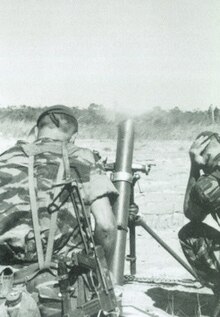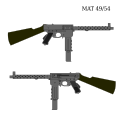
A submachine gun (SMG) is a magazine-fed automatic carbine designed to fire handgun cartridges. The term "submachine gun" was coined by John T. Thompson, the inventor of the Thompson submachine gun, to describe its design concept as an automatic firearm with notably less firepower than a machine gun. As a machine gun must fire rifle cartridges to be classified as such, submachine guns are not considered machine guns.
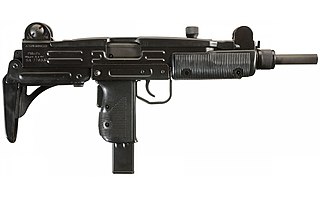
The Uzi is a family of Israeli open-bolt, blowback-operated submachine guns and machine pistols first designed by Major Uziel "Uzi" Gal in the late 1940s, shortly after the establishment of the State of Israel. It is one of the first weapons to incorporate a telescoping bolt design, which allows the magazine to be housed in the pistol grip for a shorter weapon.
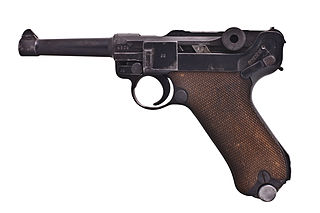
The Pistole Parabellum or Parabellum-Pistole, commonly known as just the Luger or Luger P08, is a toggle-locked recoil-operated semi-automatic pistol. The Luger was produced in several models and by several nations from 1898 to 1949.

The Thompson submachine gun is a blowback-operated, selective-fire submachine gun, invented and developed by United States Army Brigadier General John T. Thompson in 1918. It was designed to break the stalemate of trench warfare of World War I, although early models did not arrive in time for actual combat.
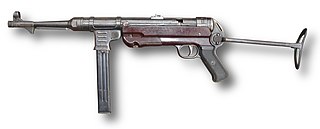
The MP 40 is a submachine gun chambered for the 9×19mm Parabellum cartridge. It was developed in Nazi Germany and used extensively by the Axis powers during World War II.

The STEN is a British submachine gun chambered in 9×19mm which was used extensively by British and Commonwealth forces throughout World War II and during the Korean War. The Sten paired a simple design with a low production cost, facilitating mass production to meet the demand for submachine guns.

The Vietnam War involved the People's Army of Vietnam (PAVN) or North Vietnamese Army (NVA), National Liberation Front for South Vietnam (NLF) or Viet Cong (VC), and the armed forces of the People's Liberation Army (PLA), Army of the Republic of Vietnam (ARVN), United States Armed Forces, Republic of Korea Armed Forces, Armed Forces of the Philippines, Royal Thai Armed Forces, Australian Defence Force, and New Zealand Defence Force, with a variety of irregular troops.

The Sterling submachine gun is a British submachine gun (SMG). It was tested by the British Army in 1944–1945, but did not start to replace the Sten until 1953. A successful and reliable design, it remained standard issue in the British Army until 1994, when it began to be replaced by the L85A1, a bullpup assault rifle.

The Kulsprutepistol m/45, also known as the Carl Gustaf M/45 and the Swedish K SMG, is a 9×19mm Swedish submachine gun (SMG) designed by Gunnar Johansson, adopted in 1945, and manufactured at the Carl Gustafs Stads Gevärsfaktori in Eskilstuna, Sweden. The m/45 was the standard submachine gun of the Swedish Army from 1945 to 1965. It was gradually replaced in Swedish service by updated Ak 4 battle rifles and Ak 5 assault rifles. The last official user of the m/45, the Swedish Home Guard (Hemvärnet), retired it from service in April 2007.

The AA-52 is one of the first French-produced guns of the post–World War II era. It was manufactured by the French government-owned Manufacture d'armes de Saint-Étienne (MAS) company. The AA-52 is still used today as a vehicle-mounted weapon due to large quantities in service, but has been replaced in the helicopter role by the Belgian FN MAG, starting with the EC 725 Caracal of the special operations units and the Air Force search and rescue teams. The AA-52 had been largely phased out for infantry use in favour of the lighter FN Minimi but remains in use.

The Fusil-mitrailleur Modèle 1924 M29, designed in 1924 by the Manufacture d'armes de Châtellerault, is a 7.5×54mm French light machine gun, which was the standard issue machine gun of the French Army from 1925 until the 1960s and was in use until 2000–2006 with the National Gendarmerie.
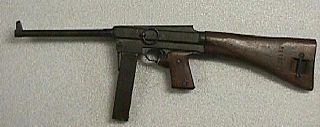
The MAS-38 is a French submachine gun designed in the 1930s and used by French and German forces during the Second World War. It was derived from a small arms development program that took place between 1918 and 1922 under the control of the Service Technique de l'Armement. A submachine gun, a light machine gun and a semiautomatic rifle were developed to replace all the existing small arms. Budgetary pressures resulting from the building of the Maginot Line led to the delay of adoption of these new arms except for the LMG 1924.
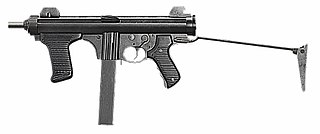
The Beretta M12 is a 9×19mm Parabellum caliber submachine gun designed by Beretta. Production started in 1959, the first users were the Italian Carabinieri, Italian State Police and the Guardia di Finanza, though in limited numbers; it was only widely issued beginning in 1978, replacing the old Beretta MAB. In 1962 the Italian Army bought a limited number of Franchi LF-57 submachine guns, judged better than the M12 but never issued to the troops, and only in 1992 the M12S2 variant was introduced, in very limited numbers. The Italian Air Force bought instead many M12S and M12S2 for the airport security units. However, the weapon had a higher initial success in the Arab countries and South America.

The PPSh-41 is a selective-fire, open-bolt, blowback submachine gun that fires the 7.62×25mm Tokarev round. It was designed by Georgy Shpagin of the Soviet Union to be a cheaper and simplified alternative to the PPD-40.
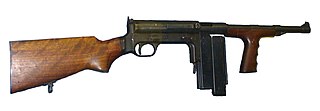
The United Defense M42, sometimes known as the Marlin for the company that did the actual manufacturing, was an American submachine gun used during World War II. It was produced from 1942 to 1943 by United Defense Supply Corp. for possible issue as a replacement for the Thompson submachine gun and was used by agents of the Office of Strategic Services (OSS). However, its usage was limited, and the Thompson continued to see service until the end of the war, alongside the M3 submachine gun, which was designed around the same time as the M42.

The Colt 9mm SMG, also known as the Colt Model 635 or Colt M635, is a 9×19mm Parabellum submachine gun manufactured by Colt, based on the M16 rifle.

The KRISS Vector is a series of weapons based upon the parent submachine gun design developed by the American company KRISS USA, formerly Transformational Defense Industries (TDI).

The M3 is an American .45-caliber submachine gun adopted by the U.S. Army on 12 December 1942, as the United States Submachine Gun, Cal. .45, M3. The M3 was chambered for the same .45 ACP round fired by the Thompson submachine gun, but was cheaper to mass produce and lighter, at the expense of accuracy. The M3 was commonly referred to as the "Grease Gun" or simply "the Greaser," owing to its visual similarity to the mechanic's tool.

The German submachine gun EMP also known as MPE was produced by the Erma factory, and was based on designs acquired from Heinrich Vollmer. The gun was produced from 1931 to 1938 in roughly 10,000 exemplars and exported to Spain, Mexico, China and Yugoslavia, but also used domestically by the SS. It was produced under license in Spain by the arsenal of A Coruña under the designation M41/44.

The PPS is a family of Soviet submachine guns chambered in 7.62×25mm Tokarev, developed by Alexei Sudayev as a low-cost personal defense weapon for reconnaissance units, vehicle crews and support service personnel.

